Introduction (Statistics for Economics) Class 11 Economics
| Table of contents |

|
| Why Economics? |

|
| Consumption, Production and Distribution |

|
| Statistics in Economics |

|
| What is Statistics? |

|
| What Statistics Does? |

|
| Conclusion |

|
Why Economics?
- Alfred Marshall defines economics as the study of human behaviour in everyday life situations, particularly in business activities.
- A consumer is someone who uses goods and services to fulfil their desires or needs.
- Consumption refers to utilising goods and services to satisfy our wants or needs directly.
- A producer is an individual or entity that creates or sells goods and services with the aim of generating income.
- Production involves the process of transforming raw materials into useful goods or services.
- Saving is the portion of income that is not spent on consumption and involves the practice of restraining immediate consumption.
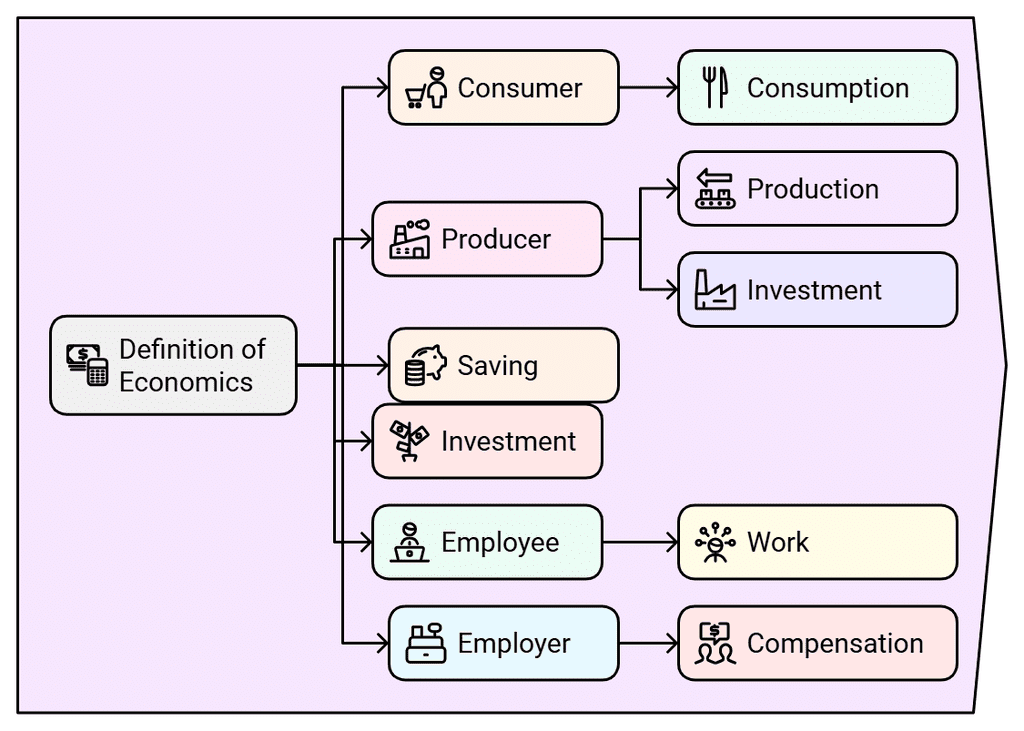
- Economic activity refers to the production, distribution, and consumption of goods and services. It encompasses all actions that involve the use of resources (such as labour, capital, and land) to produce goods and services that satisfy human wants and needs.
- The economic problem arises due to the scarcity of resources and the existence of alternative uses for those resources, resulting in the need to make choices.
- Investment refers to the expenditure made by producers to acquire assets that can generate income.
- An employee refers to an individual who receives payment in the form of salary or wages from an employer for the work they provide.
- An employer, in economics, is an individual or organisation that hires one or more employees to produce goods or services by offering them compensation in the form of salary or wages.
We cannot get something for nothing
- Scarcity is the cause of all economic issues. If there were no scarcity, there would be no economic problems. In our everyday lives, we encounter various forms of scarcity, such as long queues at train stations, overcrowded buses and trains, and shortages of essential goods. All these situations reflect scarcity because the items that meet our wants are limited in supply.
- The resources available to producers are also limited and can be used in different ways. Take the food you consume daily; it meets your need for nourishment. Farmers grow crops that produce this food. However, the resources in agriculture, like land, labour, water, and fertiliser, are fixed. These resources can also be used to grow non-food crops like rubber, cotton, and jute. Therefore, the alternative uses of resources lead to the problem of choice.
- Economics is the study of humans engaged in various economic activities.
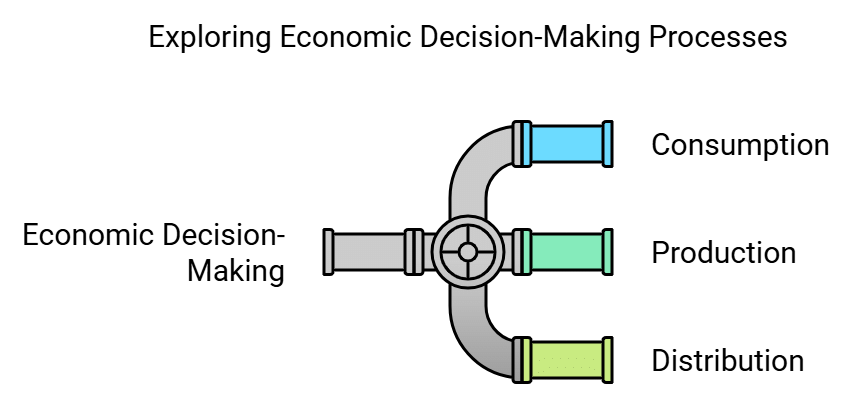
Consumption, Production and Distribution
- We're interested in understanding the decision-making process of a consumer, considering their income and numerous purchasing options, in relation to prices. This is referred to as the study of consumption.
- We are also interested in understanding the producer's decision-making process regarding what and how to produce for the market, which is the focus of the production study.
- We're interested in understanding the distribution of a country's total income or GDP, through wages, profits, and interest, excluding income from international trade and investment. This is the study of Distribution.
In addition to these three main areas of Economics, modern economics must address fundamental issues facing the country. For instance, you might want to know why some households have the ability to earn significantly more than others. You may also be curious about the number of people living in poverty, those who are middle-class, and those who are relatively wealthy. Essentially, you want more factual information regarding poverty and inequality in society. If you want to address the issues of poverty and significant inequality, you'll need to understand the facts surrounding these topics.
Statistics help identify economic relationships using data and verify them. Statistical tools are crucial for predicting future trends. These methods assist in analysing economic problems and developing policies to address them.
“Economics is the study of how people and society choose to employ scarce resources that could have alternative uses in order to produce various commodities that satisfy their wants and to distribute them for consumption among various persons and groups in society.
Difference Between Economic and Non-Economic Activity
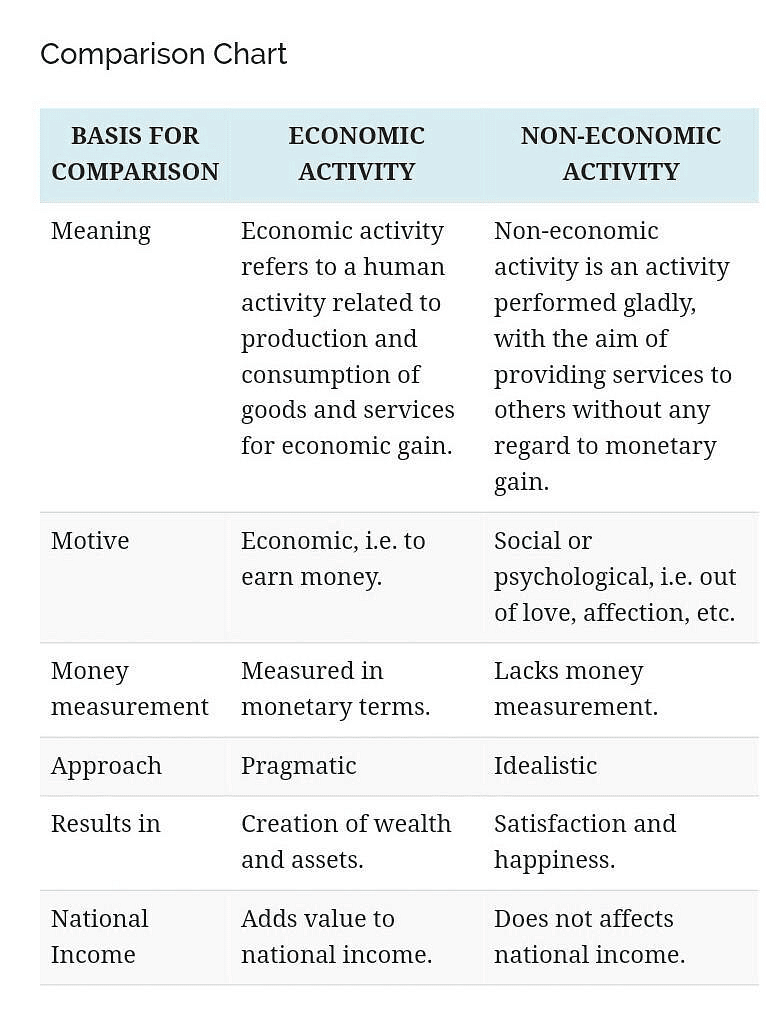
Statistics in Economics
- There is a need for specialised studies that address a country's key issues, which require a deeper understanding of economic facts or data.
- The aim of collecting data on economic issues is to understand and clarify these problems by exploring the various causes behind them.
- For example, studying poverty involves looking at factors such as unemployment, low productivity, and outdated technology. Understanding poverty is essential for developing measures or policies to reduce it. Without data on the various factors contributing to an economic issue, no analysis can be conducted, making it impossible to create effective solutions.
- Often, statistics are used to identify relationships between different economic factors. Therefore, statistical methods aid in creating suitable economic policies that address economic challenges.

What is Statistics?
Statistics involves the gathering, examination, interpretation, and presentation of numerical data. It is a field of mathematics that is applied in areas like accounting, economics, management, physics, finance, psychology, and sociology. As defined by statistician Sir Arthur Lyon Bowley, statistics is about the collection, analysis, interpretation, and presentation of numerical data.
- Plural Sense: Statistics refers to numerical information, such as population figures or employment rates.
- Singular Sense: It relates to methods for collecting, sorting, presenting, analysing, and interpreting quantitative data. Statistics is essential for economists, aiding them in understanding economic issues.
Statistics allows economists to convey economic facts clearly, aiding in the understanding of the data presented. It identifies and verifies economic relationships using data.
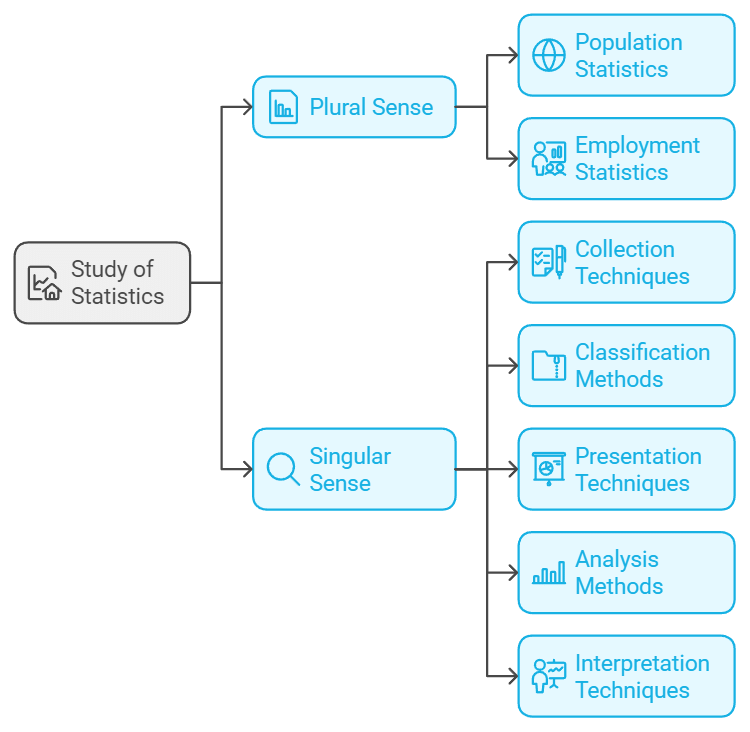
What Statistics Does?
- Economists can present economic facts accurately and unambiguously with the help of statistics.
- Statistics aid in summarising large amounts of data into a few numerical measures.
- Statistical analysis is employed to identify the correlation between various economic factors.
- Statistical studies are useful in economic forecasting.
- Statistics can assist in developing appropriate economic policies that address economic issues.
- It helps in evaluating the effectiveness of previously implemented policies.
- Economists seek to establish causal relationships between different sets of data using statistical methods.
- Policies can be formulated using statistical information.
- Statistics is utilised in making inter-sectoral and inter-temporal comparisons.
- Statistics offers a quantitative representation of economic problems.
Functions of Statistics
- Statistics can help to simplify complexities.
- It uses numbers to represent facts.
- Data is shown in a condensed manner through statistics.
- Statistics is often used in identifying relationships between various economic factors.
- The Government and policymakers utilise statistical data to create appropriate economic development policies.
- Statistics helps in understanding economic issues and uncovering their causes using both qualitative and quantitative information.
- Precise facts are more persuasive than vague claims.
- Statistics can show a correlation between two facts.
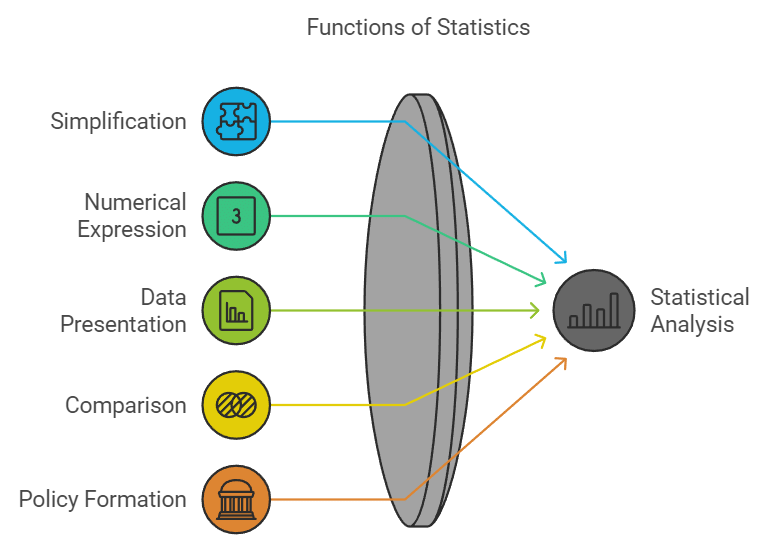
Limitations of Statistics
- The focus of statistics is not on individuals but on groups or aggregates.
- The interpretation of statistical results can sometimes lead to erroneous conclusions.
- Statistics is concerned with numerical or quantitative data only.
- Statistical laws are generally applicable to averages and not to individual cases.
- Statistics can be best utilised by experts with appropriate knowledge and skills.
- Data uniformity and homogeneity are essential in statistical analysis.
- Misuse of statistics can be its greatest limitation, as it is susceptible to such misuse.
- Statistics deals with the study of aggregates and not with individual cases.
- It is important to have proper context and reference to ensure an accurate interpretation of statistical results.
Conclusion
- Statistics is crucial in analysing economic issues like rising prices, unemployment, and poverty, helping devise and evaluate policies.
- For instance, statistical techniques can determine if family planning effectively controls population growth.
- Statistics also aid decision-making in economic policies.
- For example, to decide how much oil India should import in 2025, we must know the expected domestic production and demand.
- This information, essential for making such decisions, is only possible through statistical analysis.
|
59 videos|222 docs|43 tests
|
FAQs on Introduction (Statistics for Economics) Class 11 Economics
| 1. Why is economics considered an important field of study? |  |
| 2. How does statistics play a role in economics? |  |
| 3. What are the main types of statistical methods used in economics? |  |
| 4. What is the significance of consumption, production, and distribution in economics? |  |
| 5. How can one apply statistical methods to solve economic problems? |  |
















